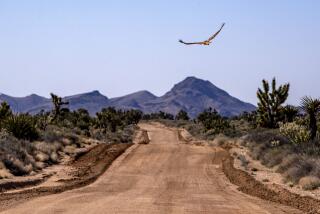Peggy Wayburn, 84; Author and Conservationist
When Peggy Wayburn sat down to write her second book about Alaska, she chose to begin with a simple statistic: Anyone wishing to explore the entire state would have to visit about one million acres per day--for a year.
It was a simple, elegant number meant to impress upon readers the enormity of a place that Wayburn argued should be left as is.
A prolific nature writer and environmentalist who was instrumental in preserving millions of acres in Alaska and creating some of Northern California’s most cherished parks, Peggy Wayburn died March 21 in San Francisco after a long illness. She was 84.
Known primarily for five books she wrote on the outdoors, Wayburn also was published in a variety of magazines and was an accomplished photographer whose images graced many calendars. She was involved in a number of conservation organizations, including the San Francisco-based Sierra Club.
A native of New York City who was a member of Phi Beta Kappa at Barnard College, she moved to San Francisco in 1945 and quickly fell in love both with the area’s beauty and with doctor and outdoorsman Edgar Wayburn. Their first date was spent hiking on Mt. Tamalpais, just north of the city. They were married in 1947.
Edgar Wayburn was a rising figure in the Sierra Club, and by default--at least initially--Peggy Wayburn was thrust into some of the state’s most contentious environmental battles.
In California, the club was battling to protect small but important places previously overlooked by the state and federal governments. The Wayburns were part of the push that would eventually lead to the creation of Point Reyes National Seashore in 1962 and, later, Redwoods National Park and Golden Gate National Recreation Area.
But in 1967, the Wayburns took their first trip to Alaska--a voyage they would take dozens more times over the next 30 years.
“What Peggy and Ed found in Alaska were vast, intact, pristine ecosystems,” said Deborah Williams, executive director of the Alaska Conservation Foundation.
“Peggy felt that human beings have a profound obligation to be good stewards to the land,” Williams said, “and she saw in Alaska both an opportunity and responsibility to do that.”
Upon returning to California, the Wayburns began pushing the Sierra Club to pay more attention to Alaska. It was a critical time for the newly created state, with tremendous pressures to divvy up tens of millions of acres of federally owned land between the fledgling state government and the many tribes native to the area.
It also was a time when there was a growing awareness that intact ecosystems in the United States were rare. Environmentalists began pointing out how the West--even with its expansive national parks and forests--was missing vital members of its natural communities. Not only did Alaska still have all its native species, but it had them in almost unimaginably large numbers.
Inspired, Wayburn wrote two books on the state. The first, “Alaska, the Great Land” was co-written by Mike Miller and published in 1974. Along with John McPhee’s “Coming Into the Country,” it was influential because it expressed how different--and how wild--Alaska still was to an audience that mostly never had seen the state, nor ever would. The book also became a staple on Capitol Hill in the 1970s as the debate over federal land in Alaska heated up in Congress.
The second book, “Adventuring in Alaska,” was the first Sierra Club adventure guide and remains in print. It was one of the first comprehensive guidebooks for the state, offering readers practical travel tips and a myriad of facts on Alaska’s natural wonders.
In December 1980, just weeks before leaving office, President Carter signed the Alaska Lands Act, which set aside 104 million acres in the state as either national parks, national wildlife refuges or national forests. Carter has since called it one of the most important accomplishments of his presidency.
In 1999, President Clinton awarded Edgar Wayburn a Presidential Medal of Freedom, citing his and Peggy’s work in Alaska during a White House ceremony.
“I think what captivated my parents about Alaska was that it was California 500 years ago and there were such great pressures [to develop it],” said Cynthia Wayburn of Seattle, one of the couple’s four children.
“What Mom was able to convey in her books was that there should be places where life can go on as it has gone on for thousands and thousands of years.”
In addition to her husband and daughter Cynthia, Peggy Wayburn is survived by two other daughters, Diana Wayburn of New York and Laurie Wayburn of Boonville, Calif.; a son, William of Seattle; and three grandchildren.
A memorial service is planned April 7 at the Presidio in San Francisco. Donations in her name can be made to the Sierra Club Foundation, Alaska Conservation Foundation or Earthjustice.
More to Read
Sign up for our Book Club newsletter
Get the latest news, events and more from the Los Angeles Times Book Club, and help us get L.A. reading and talking.
You may occasionally receive promotional content from the Los Angeles Times.









